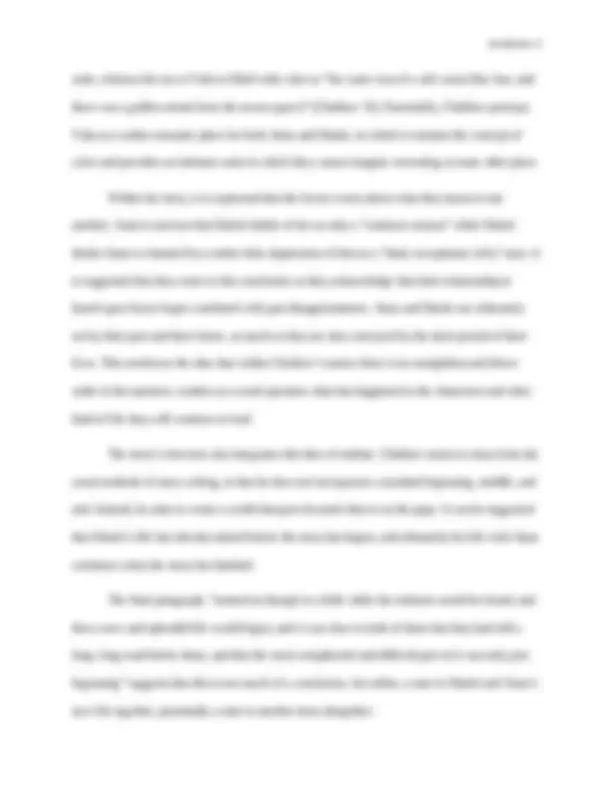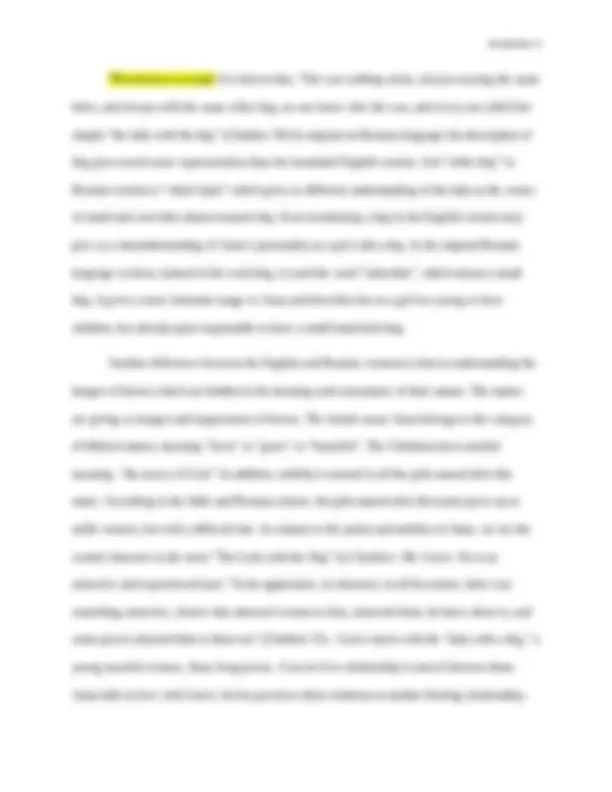





Study with the several resources on Docsity

Earn points by helping other students or get them with a premium plan


Prepare for your exams
Study with the several resources on Docsity

Earn points to download
Earn points by helping other students or get them with a premium plan
Community
Ask the community for help and clear up your study doubts
Discover the best universities in your country according to Docsity users
Free resources
Download our free guides on studying techniques, anxiety management strategies, and thesis advice from Docsity tutors
Anton Chekhov analysys The lady with the dog
Typology: Essays (university)
1 / 6

This page cannot be seen from the preview
Don't miss anything!




Alexander Ishutenko Professor Gregory Munna English 201- 8 December 2019 Anton Chekhov “The lady with the Dog” “The Lady with the Dog” – the story of the Russian writer and playwright Anton Pavlovich Chekhov, written in 1898. First published in the journal “Russian Thought” in 1899. The story focuses on two lovers that continue to have an affair despite the fact that they are both married. When Chekhov died he was laid in the town of Yalta, whereby the lovers’ in his story have their initial meeting. It can be argued that the relationship at the center of the story reflects the romance of Chekhov’s. The Lady with the Dog is portrayed as a rather typical Chekhov tale in that it reflects the main style and literary preferences of the author. The story seems to break traditional rules of storytelling, especially considering his plot and conclusion. This story is essentially describing to us what everyday people do when they get put in certain situations, we are then able to discuss and ultimately judge the characters for ourselves as Chekhov intentionally avoids showing his own opinion on the subject. We readers are able to judge the situation and the characters and decide whether or not they are doing the right thing. Add sum!!! In order to understand this story to its full degree, we have to guess what has happened prior to the events in the story, and what has happened after them. Dmitri finally realizes he has disoriented himself just as he is about to confuse Anna. We can suggest that Dmitri is searching for a verdict in that he is redeemed by the innocent romance with Anna. The story itself provides a large amount of uncertainty. It is presented that Anna somewhat changes
Dmitri’s desire for life but also, that Dmitri’s love for her further complicates his idea of home. We can suggest that Moscow seems, for Dmitri, as he was trapped in a madhouse, this could be because he remembers Yalta as something light and beautiful. Chekhov suggests that the way towards love and women for Dmitri is not necessarily an easy one. It can be argued that Dmitri’s commitment to the females or “lower race” essentially only brings confusion and a slight hope for future redemption. Dmitri acknowledges that he is living two lives, “one open, seen and known by all who cared to know” and another “running its course in secret”, as a result of this idea the story ends on a rather unclear note. It seems the only way the couple can resolve their fears is to essentially recognize that they are at the beginning of a “new life,” one that they will not willingly enjoy for a long time to come. The Lady with the Dog is a realistic story that shows two people having an affair. The narrative is presented in a rather straightforward manner. It seems as though Chekhov does not tend to rely on much symbolism. This presents us with a view of how life really is. Analysis STYLE It can be argued that “The Lady with the Dog” is essentially one of Chekhov’s best-known stories. This story is one in which demonstrates Chekhov’s rather powerful style in that he seems to never say any more than what is most relevant. It is shown that he portrays emotional complexity through using minimal words, and as a result this maintains the intensity of his characters’ feelings. A key example of this taking place in the text is when Chekhov expresses Dmitri’s desire for Anna in that he says, “she, this little woman, in no way remarkable, lost in a provincial crowd, with a vulgar lorgnette in her hand, filled his whole life now, was his sorrow and his joy. He thought and dreamed” (Chekhov 51). ANALYSIS COLOR Chekhov also uses the idea of color to represent the feelings of the characters in that the aging of Dmitri’s hair is described as greying, and he often wears grey
TRanslaitaon exampls It is shown that, “She was walking alone, always wearing the same béret, and always with the same white dog; no one knew who she was, and every one called her simply “the lady with the dog” (Chekhov 50) In original on Russian language the description of dog gives much more representation than the translated English version. Just “white dog” in Russian version is “white Spitz” which gives us different understanding of the lady as the owner of small and cute little almost manual dog. Even mentioning a dog in the English version may give us a misunderstanding of Anna’s personality as a girl with a dog. In the original Russian language version, instead of the word dog, is used the word “sobachka”, which means a small dog. It gives a more feminine image to Anna and describes her as a girl too young to have children, but already quite responsible to have a small hand-held dog. Another difference between the English and Russian versions is that in understanding the images of heroes which are hidden in the meaning and consonance of their names. The names are giving us images and impressions of heroes. The female name Anna belongs to the category of biblical names, meaning "favor" or "grace" or "beautiful". The Christians have another meaning: "the mercy of God." In addition, nobility is natural in all the girls named after this name. According to the bible and Russian culture, the girls named after this name grow up as noble women, but with a difficult fate. In contrast to the purity and nobility of Anna, we see the central character in the story "The Lady with the Dog" by Chekhov. Mr. Gurov. He is an attractive and experienced man: "In his appearance, in character, in all his nature, there was something attractive, elusive that attracted women to him, attracted them; he knew about it, and some power attracted him to them too" (Chekhov 51). Gurov meets with the "lady with a dog," a young married woman, Anna Sergeyevna. A secret love relationship is struck between them. Anna falls in love with Gurov, but he perceives these relations as another fleeting relationship.
Dmitry Dmitrievich Gurov works in a bank, although he owes two houses and He is from Moscow Concl!!Given the already pre-existing conventions of a short story, Chekhov’s The Lady with the Dog may come across as rather unusual, but nonetheless this is what makes it considerably more interesting. This style of his writing essentially adds to the realism of the story in that in real life, things tend to just happen. The Lady with the Dog asks more questions, rather than providing us with answers. This is reinforced with the ending of the story, as readers are ultimately left to wonder regarding the future of the two lovers.